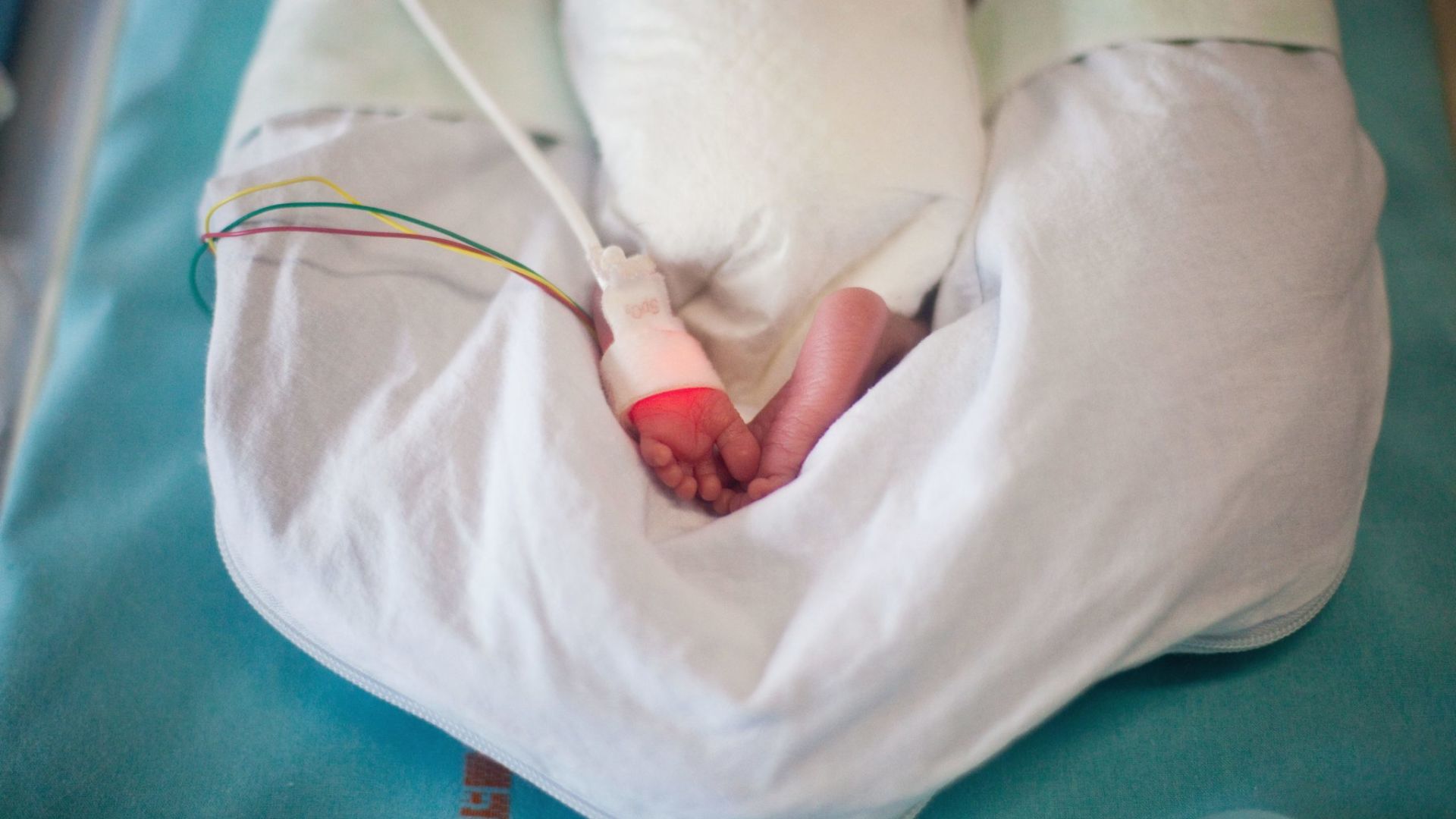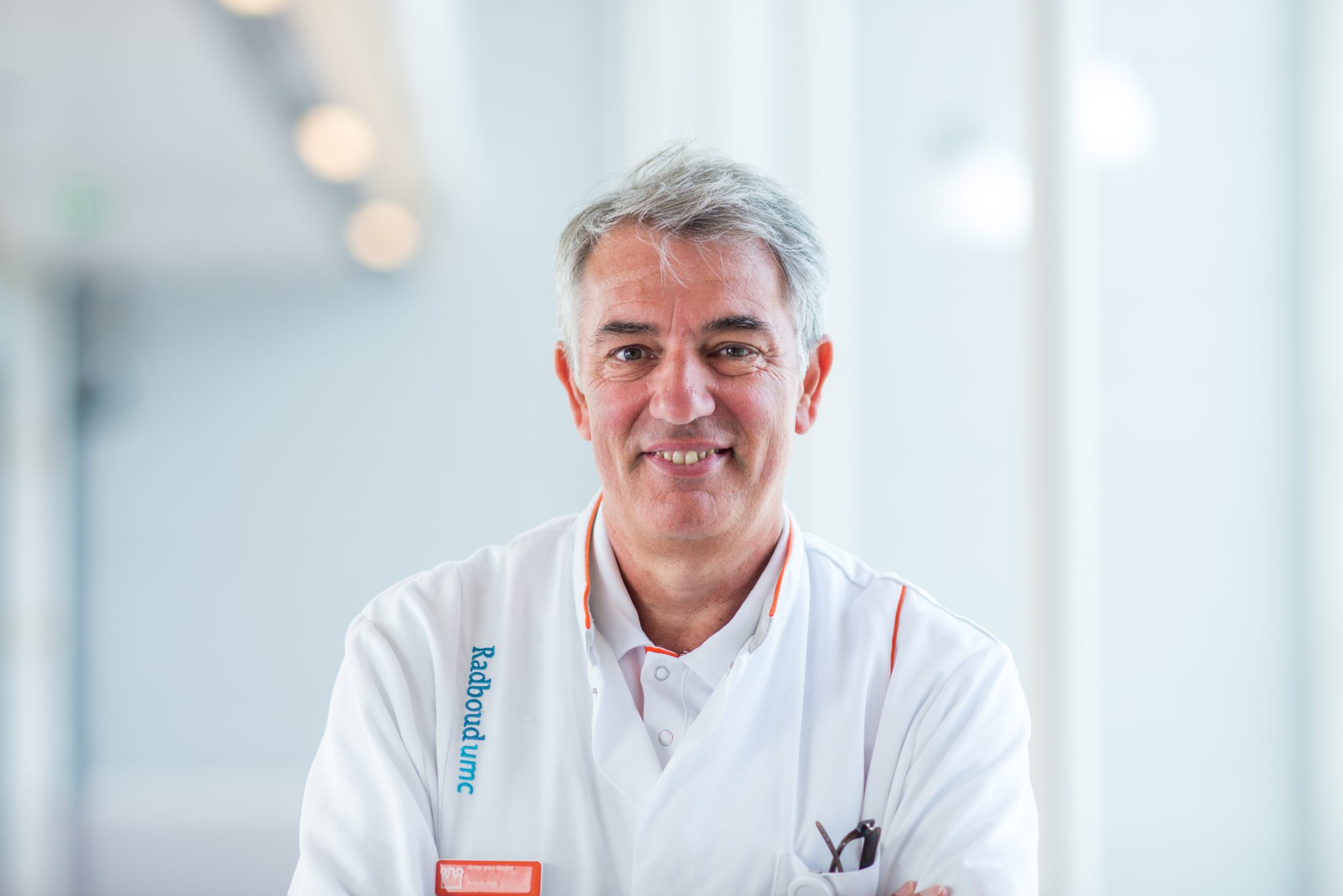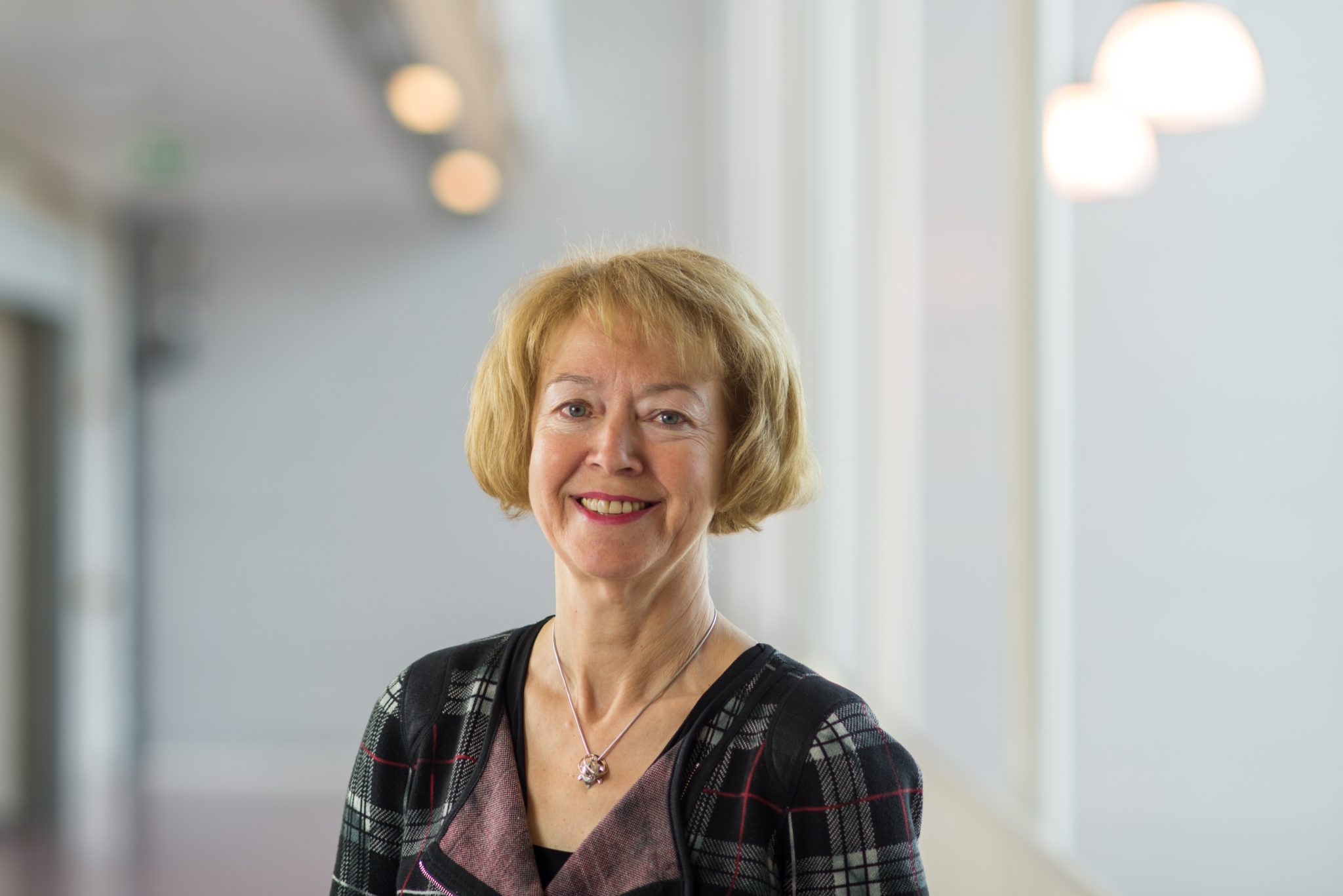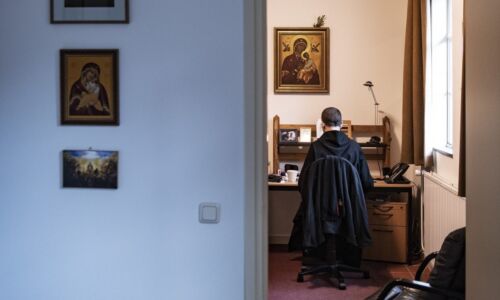Operating at the interface between life and death
-
 Photo: Getty Images-VOISIN/PHANIE
Photo: Getty Images-VOISIN/PHANIE
God is never far away in a hospital. He plays an important role in the history of Radboud university medical center and in the minds of its religious patients. As a doctor, how do you deal with this? Fertility programmes and treatments for seriously ill babies remain sensitive topics even without appealing to religious morality.
Does he ever feel like he’s sitting in God’s chair? Yes, admits neonatologist Arno van Heijst. Sometimes, as he wrestles with a dilemma on whether or not to continue to treat a new-born, he hears a small voice in his head. ‘Stay away from these kinds of decisions,’ whispers the voice. ‘Who are you to take a decision on this life?’
‘Discontinuing treatment is not the same as active life termination’
‘On the other hand,’ says Van Heijst, ‘it’s us doctors who decide to start a treatment in the first place. At times we begin full of hope, but the treatment fails to deliver the desired results. In these cases, you have no choice but to talk about whether it’s in the interests of the child to continue.’
Lower limit
Van Heijst is Head of the Neonatology Department at Radboud university medical center. Half of all babies who end up on his ward were born prematurely. In the Netherlands, babies can receive treatment from 24 weeks of pregnancy onwards. The decision is up to the parents. Until 2010, the limit was set at 25 weeks. As technological advances make more possible, doctors are beginning to wonder what is desirable, says Van Heijst. He chairs a national working group committed to re-examining this guideline. What’s the absolute lower limit? What factors play a role in the decision to offer treatment or not?

If doctors and nurses don’t offer care to extremely premature babies, the babies won’t make it. Four out of ten babies born at 24 weeks still die at the Neonatology Department and research shows that some of the survivors suffer from neurological, mental and/or physical disabilities.
A far-reaching decision about a baby’s life is not something you take alone, says Van Heijst. ‘I always say that if anyone at our department has any doubts about whether a treatment makes sense – no matter whether they’re a doctor or a cleaner – they must speak up. We then sit down and hold a moral discussion. This happens according to a set protocol. The discussion is chaired by an ethicist.’
The discussion doesn’t centre on the medical treatment, but on the consequences it may have, the severity of the illness or disability, and the child’s prognosis. The parents’ religious beliefs may also be a factor in the discussion. Parents who are Reformed Calvinists may, for instance, want doctors to proceed with a treatment because to stop would be unacceptable from the perspective of their faith. ‘Discontinuing treatment is viewed by some as a form of euthanasia, but from a legal perspective, it isn’t. These are sometimes severely ill patients who can only live with medical support. Discontinuing treatment is not the same as active life termination.’
Pastor
It sometimes helps to explain this to very religious parents. But usually, in Van Heijst’s experience, it is not faith that plays the decisive role. Once parents understand that their child has a poor prognosis, they need time to accept it. ‘I once had parents here who said their Pastor had told them they weren’t allowed to discontinue the treatment. I asked how the Pastor could know what state their child was in, and invited him to come and see for himself. We went to look at the baby together. In the end he said to me: ‘You must do what you think is best.’’
Traditionally, Radboud university medical center has had the reputation of following the precepts of the Catholic Church, says Van Heijst. And there are still people who say to him: ‘But in Nijmegen you never discontinue a treatment, do you?’ As if every life, no matter how hopeless, is holy. He knows from stories that doctors in the past were indeed accountable to the Bishops who stood guard over the hospital’s Catholic identity, for example in abortion cases.
‘I’ve worked here for thirty years, and a lot has changed during this time,’ he says. ‘I don’t think we’re more reticent than other hospitals, but this kind of reputation is hard to shake off.’
Mothers
Didi Braat echoes Arno van Heijst’s words: Catholic identity used to play a more important role at the hospital, whereas guidelines are now driven by social debate. Braat is head of the Obstetrics and Gynaecology Department at Radboud university medical center. There was a time when lesbian couples did not qualify for fertility treatment in Nijmegen, she remembers. ‘But as doctors, we’ve all taken an oath. It’s our duty to help people to the best of our abilities. What could be more beautiful than helping two people who love one another to realise their dream of having a child, and why should it matter that they are two women?’
‘What could be more beautiful than helping two people to realise their dream of having a child?’
For years now, lesbian couples have been welcome at the Gynaecology Department. Braat doesn’t remember exactly when the shift took place, but she finds the current policy only logical. Single women can also get treatment in Nijmegen. ‘In the latter cases, we do take special care to consider the interests of the child.’ To do so gynaecologists use the ‘moral contraindications’ protocol devised by the Dutch Society for Obstetrics and Gynaecology (NVOG). Based on the protocol’s questions, doctors and other parties involved try to assess whether there is too much risk of severe damage to the unborn child. Will the mother be able to take on the task of raising the child single-handedly? Does she have a strong support network? ‘Sometimes the discussion is attended by a GP or the patient herself.’

Didi Braat has also had occasion to welcome a Pastor in her office. There was a couple who couldn’t get pregnant, but who due to their Reformed background had issues with IVF because the embryos that were not reinserted would be destroyed. According to their faith, an embryo was already a person, and under no circumstances was it permitted to kill a person. The Pastor came along to hear how the fertility treatment works. ‘It can help tremendously to explain what you’re doing. If people have moral objections to the creation of supernumerary embryos, we can offer them the option of only fertilising one egg. Normally, we perform IVF with multiple eggs, which are all fertilised, so we can select and reinsert the best one. Supernumerary embryos are frozen, so they can be reinserted at a later stage if the pregnancy fails, or for a following pregnancy. This makes for higher odds of success.’
Another solution is to harvest multiple eggs from a woman, only fertilise one, and freeze the remaining eggs for later use. Since an egg is different to an embryo, any objection to ‘the creation of surplus embryos’ disappears and people can get help getting pregnant with a clear conscience.
Embryo
Personally, Braat wouldn’t refer to the procedure as the ‘destruction’ of an embryo. She likes to explain this to the couples in some detail. ‘When an egg is fertilised, we first look at whether its cells continue to divide. If they don’t, the embryo is not viable. Only embryos that divide further are frozen and later thawed. Some don’t survive this stage. If we get them out of the nitrogen and they don’t respond, they’ve simply reached the end of their life.’
‘We’re looking into the option of offering surrogate motherhood’
To be clear: in this context an embryo is microscopic material contained in a straw, so small it can’t be seen with the naked eye. People can also pick up the thawed straw. Just the other day, a Muslim couple came to the Department, says Braat. They had received a letter asking whether they wanted their frozen embryos to be kept. ‘No’, was their answer; their family was already complete. But they did want to take up the offered opportunity to say good-bye properly at home. ‘This happens six or seven times a year,’ says Braat, and it is by no means always due to religious beliefs. ‘I think it’s beautiful.’

Radboud university medical center specialises in fertility preservation, in other words: helping people who have or have had cancer to have a child. For example, emergency IVF treatments are offered where eggs (or embryos) are frozen before a woman undergoes chemo treatment. After the illness the eggs can be thawed, fertilised, and reinserted in the uterus. But what if, due to cancer, a woman no longer has a uterus? ‘We’ve asked the Executive Board of our hospital to investigate the possibility of pregnancy via a surrogate mother,’ explains Braat. ‘This option is increasingly the subject of social debate. It forces us to think about it carefully and thoroughly. At the moment, we’re looking into the option of offering surrogate motherhood. In the coming months, we’ll investigate what this could mean for our hospital.’
All this to say that Radboud university medical center is by no means a conservative hospital – or not anymore. Her colleague Arno van Heijst, from the Neonatology Department, recently wrote a letter to the legal department. Imagine, he wrote, that he had a baby in his Department who was in hopeless and unbearable distress and the doctor in charge decided, after careful deliberation with his team, to actively terminate the baby’s life – something the law permits – would this doctor have the hospital’s support? And how would the Executive Board feel about it? ‘This question was submitted to the hospital’s Ethics Committee, and was considered in great depth. The answer was that in a case like this, active life termination would be allowed.’ Van Heijst is currently working on a protocol for such exceptional cases within the hospital. His conclusion: times have changed.
Single rooms
At the new Neonatology Department of Radboud university medical center, completed around 2020, the goal is to give all new-born babies their own room. The main advantage for parents is, of course, that they have more privacy. An additional advantage, according to Head of Department Arno van Heijst, is that people have more room to perform rituals. This may be the baptism of a baby that recently died, or a farewell. ‘We’ve had Moroccan families of 25 members gather here. I think it’s beautiful, and it’s important that people can be there for each other. Rituals are often essential for the parents to be able to go on with their lives.’



